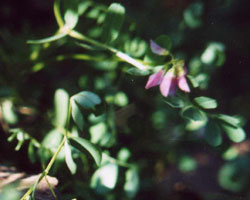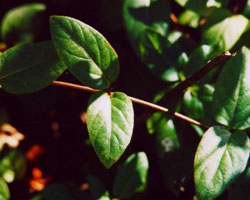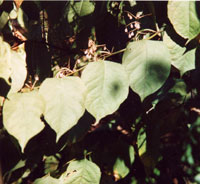Invasive Plants

Crown Vetch (Coronilla varia) could be a charming little plant, with its pink bloom, if it didn’t spread, and spread, and dominate all other plants in the field.
|

Japanese honeysuckle (Lonicera Japonica) forms a fast-growing vine that twists its way up shrubs and small trees to finally smother them.
|

Japanese knotweed (Polygonum cuspidatum) is spreading along the riversides of New Jersey, standing tall on hollow stems that recall bamboo, and forming stands too thick for anything else to grow.
|
Phragmites
 |
|
| Photo: Carol O’Neill, 10/03 | |
Phragmites or common reed (Phragmites australis) shows silvery plumes in the marsh at the west end of Donaldson Park–Barwood property that we hope the county will add to the Ayres Beach Natural Area. Phragmites has been a mystery: native or nonnative? Forms of it grow on every continent except Antarctica. Recent (1999) peat studies prove that forms of it dwelt among other vegetation in New England marshes long before Columbus or the Vikings. Yet in the late nineteenth century a genetically distinct invasive form seems to have been introduced from somewhere to spread all along the East Coast. As a clonal grass, a given stand can in essence be one huge plant that spreads fiercely, lays down deep roots, and crowds out more varied wetland plants. Wildlife find it acceptable shelter but very poor food. Still, it certainly is pretty in the fall. (Information source: USDA, Biological Control of Invasive Plants in the Eastern United States, 2002, in our environmental drawer at the library Reference Department.)
Highland Park Native Plant Reserve |
Page 1 Page 2 Page 3 Page 4 Page 5 Page 6 Page 7 |
Nature by the river. The Highland Park Native Plant Reserve offers you a stroll among restored native trees, shrubs, and flowers along the Raritan River. Small signs by the plants name them but do much more. They tell their stories. How was a plant used by Native Americans or early colonists? How does it support birds and other wildlife? What time of year can you come by to see it bloom? In all, the Native Plant Reserve offers not just a pretty spot, but a fascinating education, while all the while restoring a natural riverside in the heart of an urban center.

Getting there. River Road, Highland Park (enter at the gravel parking area across from the foot of Harrison Avenue). You’ll see the plantings set well back from the road behind the parking. The reserve occupies one large section of the undeveloped riverside strip along River Road north of the Route 27 bridge. At the reserve’s north edge, Johnson Park begins, with a small stream and bikeway entrance a few yards north, and a marshy pond a little farther, where herons, egrets, geese, sora rail, turtles, frogs, and muskrats may reward nature-watchers.
How the reserve got started. Owned by the Borough of Highland Park, the reserve is managed by the volunteers of the Highland Park Shade Tree Advisory Committee— with many a hard hour of grubbing, planting, watering, and mulching. The effort restores something of the quality of the site’s wetland soil that had become covered by gravelly fill and gives tender plantings a good start toward reclaiming their place. Matching grants made it possible, first from the Middlesex County Urban Forestry Advisory Committee (1994) and later the Green Communities grant of the NJ Department of Environmental Protection, Division of Parks and Forestry (1997– 8). Many-sided cooperation by the municipality and utility agencies (owners of underground pipelines) made the project possible, restoring natural space to the urban setting.
Watershed management through plants. We all live in a watershed— the land area that contributes water to a specific surface- water body, such as a pond, lake, or river, in this case the Raritan River. Common activities throughout the watershed— like how you dispose of used motor oil, or fertilize your lawn and garden— can harm water quality, even when you do these things far from any shore. Rain can wash lawn chemicals, motor oil, pet waste, and many other pollutants down roads, sidewalks, and storm drains into the river. But vegetation and open space along Highland Park’s riverfront can prevent or reduce erosion and water pollution by slowing and filtering polluted runoff.